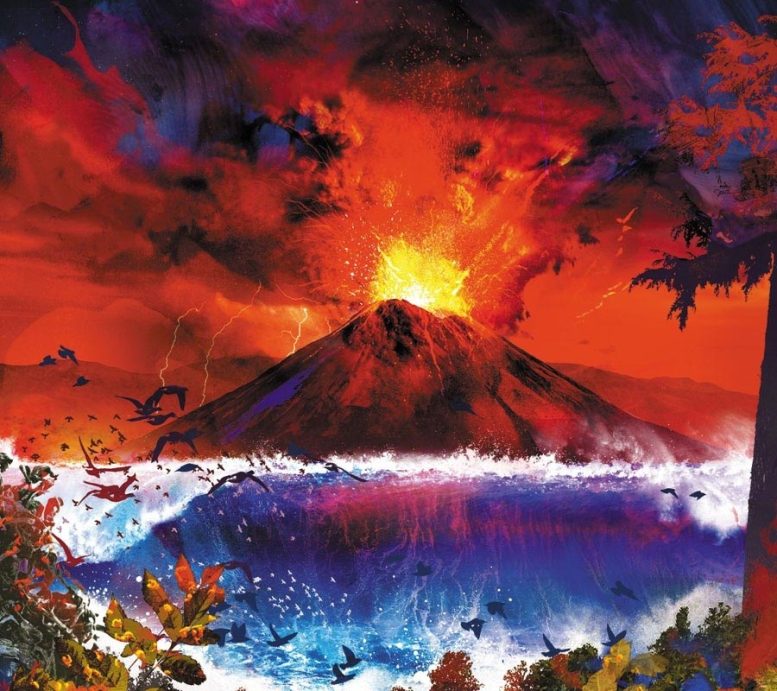
Artist’s illustration of supervolcano eruption and tsunami event. Credit: Andy Potts
In the last 40,000 years, there have been at least ten gigantic landslides of more than 100 cubic kilometers (24 cubic miles) in the North Atlantic Ocean alone. Each of these was capable of producing waves tens to hundreds of meters in height and according to a new report, this is only one of the many possible planetary disasters that could cause extinction.
The World Economic Forum published its 2013 global risks report this week, including a section on low-probability, high-impact risks resulting from human activity. This section was produced in collaboration with the journal Nature.
There is plenty of evidence of natural disasters in the geological record, ranging from asteroid impacts to supervolcanoes and Earth is now in the middle of a flare-up of supervolcanic activity. Over the past 13.5 million years, there have been 19 giant eruptions that spewed forth 1,000 cubic kilometers (240 cubic miles) of rock. This is enough to coat an entire continent with a few centimeters of ash and push the planet into a nuclear winter. The most recent of such eruptions happened 74,000 years ago, at the volcano Toba in Indonesia. It was so catastrophic that it’s been blamed for starting the last ice age and culled the human population to about 10,000 people. One estimate suggests that there’s a 1% chance of a super-eruption happening in the next 460-7,200 years.
The four most active supervolanic systems in the world, Toba, Campi Flegrei in Italy, Yellowstone in the USA, and Taupo in New Zealand are being monitored for groundswells and seismic swarms, which are small clusters of earthquakes that could signal moving magma. Scientists are drilling into the Campi Flegrei caldera in order to find out whether its upwards rise, of 3.5 meters (11.5 feet) since 1969, is caused by underground steam or a pool of magma. The caldera is 13 kilometers (8 miles) wide and includes the city of Naples. It is thought that there needs to be 50% liquid magma in order for a super-eruption to occur.
Death by fungus is another global risk published in the report. Of all of the pathogens being tracked, 70% of the recorded global and regional extinctions have been caused by fungi, and now they threaten amphibians, bats, and bees. If all five crop staples were hit with fungal outbreaks at the same time, at least 60% of the Earth’s population would go hungry. Scientists estimate that there are 1.5 million to 5 million species of fungi in the world, but only a fraction of these, 100,000, have been identified.
Space holds plenty of threats as well. Solar flares can fry electricity grids by generating intense currents in wires. In 1859, the most recent solar megastorm sparked fires in telegraph offices. If it had occurred today, a similar-sized storm would have knocked out satellites and shut down power grids for months. According to Adrian Melott, a cosmologist at the University of Kansas in Lawrence, and Brian Thomas, an astrophysicist at Washburn University in Topeka, Kansas, a solar flare 20 times larger than the one from 1859 hit Earth in 774 AD. For a technological civilization like today, it could kill hundreds of millions of people, and set humanity back 150 years.
A blast of radiation from a nearby γ-ray burst, if directed at Earth from within 200 parsecs away, would inundate the Earth with enough high-energy photons to wipe out 30% of the ozone layer for nearly a decade. This sort of event happens every 300 million years, but it would double the amount of UV light reaching the ground, destroying phytoplankton, which make up the basis of the ocean’s food web. This could also cause a 60% reduction in crop yields due to UV damage.
Long-soft γ-ray bursts resulting from the collapse of massive stars could cause extinctions, but these are even rarer than short-hard bursts. Scientists have suggested that it’s possible that a γ-ray blast hit Earth and caused the mass extinction at the end of the Ordovician period, 440 million years ago.
Water, crucial to humanity’s survival and a popular vacation destination for many, could have a major impact on civilization just as easily as any of the aforementioned events. Eight thousand years ago, an underwater sediment buildup the size of Scotland slipped off the west coast of Norway and raced along the sea floor. The Storegga slide triggered a 20-meter (66-foot) tsunami that ran up the nearby Shetland Islands, and probably wiped out some coastal tribes as it hit shores around northern Europe. Scientists note that there are far larger piles of sediment around today than Storegga, including deposits along the coast of southern Alaska and off the Amazon, Niger and Nile river deltas.
Reference: “Planetary disasters: It could happen one night” by Nicola Jones, 8 January 2013, Nature.
DOI: 10.1038/493154a









Be the first to comment on "Possible Planetary Disasters That Could Cause Extinction"